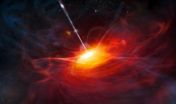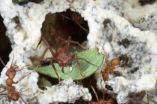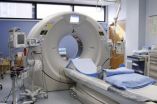(Press-News.org) "This quasar is a vital probe of the early Universe. It is a very rare object that will help us to understand how supermassive black holes grew a few hundred million years after the Big Bang," says Stephen Warren, the study's team leader.
Quasars are very bright, distant galaxies that are believed to be powered by supermassive black holes at their centres. Their brilliance makes them powerful beacons that may help to probe the era when the first stars and galaxies were forming. The newly discovered quasar is so far away that its light probes the last part of the reionisation era [1].
The quasar that has just been found, named ULAS J1120+0641 [2], is seen as it was only 770 million years after the Big Bang (redshift 7.1, [3]). It took 12.9 billion years for its light to reach us.
Although more distant objects have been confirmed (such as a gamma-ray burst at redshift 8.2, eso0917 - http://www.eso.org/public/news/eso0917/, and a galaxy at redshift 8.6, eso1041 - http://www.eso.org/public/news/eso1041/), the newly discovered quasar is hundreds of times brighter than these. Amongst objects bright enough to be studied in detail, this is the most distant by a large margin.
The next most-distant quasar is seen as it was 870 million years after the Big Bang (redshift 6.4). Similar objects further away cannot be found in visible-light surveys because their light, stretched by the expansion of the Universe, falls mostly in the infrared part of the spectrum by the time it gets to Earth. The European UKIRT Infrared Deep Sky Survey (UKIDSS) which uses the UK's dedicated infrared telescope [4] in Hawaii was designed to solve this problem. The team of astronomers hunted through millions of objects in the UKIDSS database to find those that could be the long-sought distant quasars, and eventually struck gold.
"It took us five years to find this object," explains Bram Venemans, one of the authors of the study. "We were looking for a quasar with redshift higher than 6.5. Finding one that is this far away, at a redshift higher than 7, was an exciting surprise. By peering deep into the reionisation era, this quasar provides a unique opportunity to explore a 100-million-year window in the history of the cosmos that was previously out of reach."
The distance to the quasar was determined from observations made with the FORS2 instrument on ESO's Very Large Telescope (VLT) and instruments on the Gemini North Telescope [5]. Because the object is comparatively bright it is possible to take a spectrum of it (which involves splitting the light from the object into its component colours). This technique allowed the astronomers to find out quite a lot about the quasar.
These observations showed that the mass of the black hole at the centre of ULAS J1120+0641 is about two billion times that of the Sun. This very high mass is hard to explain so early on after the Big Bang. Current theories for the growth of supermassive black holes predict a slow build-up in mass as the compact object pulls in matter from its surroundings.
"We think there are only about 100 bright quasars with redshift higher than 7 over the whole sky," concludes Daniel Mortlock, the leading author of the paper. "Finding this object required a painstaking search, but it was worth the effort to be able to unravel some of the mysteries of the early Universe."
INFORMATION:
Notes
[1] About 300 000 years after the Big Bang, which occurred 13.7 billion years ago, the Universe had cooled down enough to allow electrons and protons to combine into neutral hydrogen (a gas without electric charge). This cool dark gas permeated the Universe until the first stars started forming about 100 to 150 million years later. Their intense ultraviolet radiation slowly split the hydrogen atoms back into protons and electrons, a process called reionisation, making the Universe more transparent to ultraviolet light. It is believe that this era occurred between about 150 million to 800 million years after the Big Bang.
[2] The object was found using data from the UKIDSS Large Area Survey, or ULAS. The numbers and prefix 'J' refer to the quasar's position in the sky.
[3] Because light travels at a finite speed, astronomers look back in time as they look further away into the Universe. It took 12.9 billion years for the light from ULAS J1120+0641 to travel to telescopes on Earth so the quasar is seen as it was when the Universe was only 770 million years old. In those 12.9 billion years, the Universe expanded and the light from the object stretched as a result. The cosmological redshift, or simply redshift, is a measure of the total stretching the Universe underwent between the moment when the light was emitted and the time when it was received.
[4] UKIRT is the United Kingdom Infrared Telescope. It is owned by the UK's Science and Technology Facilities Council and operated by the staff of the Joint Astronomy Centre in Hilo, Hawaii.
[5] FORS2 is the VLT's FOcal Reducer and low dispersion Spectrograph. Other instruments used to split up the light of the object were the Gemini Multi-Object Spectrograph (GMOS) and the Gemini Near-Infrared Spectrograph (GNIRS). The Liverpool Telescope, the Isaac Newton Telescope and the UK Infrared Telescope (UKIRT) were also used to confirm survey measurements.
More information
This research was presented in a paper to appear in the journal Nature on 30 June 2011.
The team is composed of Daniel J. Mortlock (Imperial College London [Imperial], UK), Stephen J. Warren (Imperial), Bram P. Venemans (ESO, Garching, Germany), Mitesh Patel (Imperial), Paul C. Hewett (Institute of Astronomy [IoA], Cambridge, UK), Richard G. McMahon (IoA), Chris Simpson (Liverpool John Moores University, UK), Tom Theuns (Institute for Computational Cosmology, Durham, UK and University of Antwerp, Belgium), Eduardo A. Gonzales-Solares (IoA), Andy Adamson (Joint Astronomy Centre, Hilo, USA), Simon Dye (Centre for Astronomy and Particle Theory, Nottingham, UK), Nigel C. Hambly (Institute for Astronomy, Edinburgh, UK), Paul Hirst (Gemini Observatory, Hilo, USA), Mike J. Irwin (IoA), Ernst Kuiper (Leiden Observatory, The Netherlands), Andy Lawrence (Institute for Astronomy, Edinburgh, UK), Huub J. A. Rottgering (Leiden Observatory, The Netherlands).
ESO, the European Southern Observatory, is the foremost intergovernmental astronomy organisation in Europe and the world's most productive astronomical observatory. It is supported by 15 countries: Austria, Belgium, Brazil, the Czech Republic, Denmark, France, Finland, Germany, Italy, the Netherlands, Portugal, Spain, Sweden, Switzerland and the United Kingdom. ESO carries out an ambitious programme focused on the design, construction and operation of powerful ground-based observing facilities enabling astronomers to make important scientific discoveries. ESO also plays a leading role in promoting and organising cooperation in astronomical research. ESO operates three unique world-class observing sites in Chile: La Silla, Paranal and Chajnantor. At Paranal, ESO operates the Very Large Telescope, the world's most advanced visible-light astronomical observatory and two survey telescopes. VISTA works in the infrared and is the world's largest survey telescope and the VLT Survey Telescope is the largest telescope designed to exclusively survey the skies in visible light. ESO is the European partner of a revolutionary astronomical telescope ALMA, the largest astronomical project in existence. ESO is currently planning a 40-metre-class European Extremely Large optical/near-infrared Telescope, the E-ELT, which will become "the world's biggest eye on the sky".
Links
- Research paper: http://www.eso.org/public/archives/releases/sciencepapers/eso1122/eso1122.pdf
- Photos of the VLT: http://www.eso.org/public/images/archive/category/paranal/
Contacts
Daniel Mortlock
Astrophysics Group, Blackett Laboratory, Imperial College London
London, United Kingdom
Tel: +44 20 7594 7878
Email: d.mortlock@imperial.ac.uk
Bram Venemans
ESO Astronomer
Garching bei München, Germany
Tel: +49 89 3200 6631
Email: bveneman@eso.org
Richard Hook
ESO, La Silla, Paranal, E-ELT and Survey Telescopes Public Information Officer
Garching bei München, Germany
Tel: +49 89 3200 6655
Email: rhook@eso.org
Most distant quasar found
2011-06-30
ELSE PRESS RELEASES FROM THIS DATE:
Study confirms CT lung cancer screens save lives; other analyses underway
2011-06-30
PROVIDENCE, R.I. [Brown University] — Research results from the National Lung Screening Trial, published online June 29 in the New England Journal of Medicine confirm that helical low-dose CT (LDCT) scans for lung cancer reduce deaths in heavy smokers by 20 percent compared to X-ray scans, but several other key findings from the data gathered in the study, including cost-effectiveness, will be released in the next six months, said a Brown University statistician who helped lead the massive government-funded study.
"The results of the study say that the time has come for ...
Scientists use 'optogenetics' to control reward-seeking behavior
2011-06-30
(Embargoed) CHAPEL HILL, N.C. – Using a combination of genetic engineering and laser technology, researchers at the University of North Carolina at Chapel Hill have manipulated brain wiring responsible for reward-seeking behaviors, such as drug addiction. The work, conducted in rodent models, is the first to directly demonstrate the role of these specific connections in controlling behavior.
The UNC study, published online on June 29, 2011, by the journal Nature, uses a cutting-edge technique called "optogenetics" to tweak the microcircuitry of the brain and then assess ...
Scientists shed light on the private lives of electrons
2011-06-30
A Princeton researcher and his international collaborators have used lasers to peek into the complex relationship between a single electron and its environment, a breakthrough that could aid the development of quantum computers.
The technique reveals how an isolated electron and its surroundings develop a relationship known as a Kondo state – a state of matter that is of great interest to physicists and engineers. The results not only yield insights into a long-standing quandary in theoretical physics, but also may help scientists understand how to store information at ...
At-HomeMedSpa.com Announces Addition of "La Roche-Posay" Brand to Their Online Product Catalog
2011-06-30
www.At-HomeMedSpa.com has announced the addition of the La-Roche-Posay line, to their online store. La Roche-Posay is famous for using thermal spring water rich in selenium. La Roche-Posay is an internationally known line of skincare sold all over Europe, Asia, Latin America, and now it is available at At-HomeMedSpa in the United States! The unique thermal spring water comes from a small village in central France called La Roche-Posay, which is where the brand's name is derived from.
La Roche-Posay Thermal Spring Water is the result of rainwater flowing over vast expanses ...
Fungus farming ant genome reveals insight into adaptation of social behavior
2011-06-30
June 30, 2011 – The development of agriculture was a significant event in human cultural evolution, but we are not the only organisms to have adopted an agricultural way of life. In a study published online today in Genome Research (www.genome.org), researchers have sequenced the genome of a fungus farming leaf-cutting ant, revealing new insights into the genetics and molecular biology behind this unusual lifestyle.
Found in Central and South America as well as the southern United States, leaf-cutting ants have evolved a symbiotic relationship with fungus. By breaking ...
Study shows 20 percent reduction in lung cancer mortality with low-dose CT vs chest X-ray
2011-06-30
Scientists have found a 20 percent reduction in deaths from lung cancer among current or former heavy smokers who were screened with low-dose helical computed tomography (CT) versus those screened by chest X-ray. The primary research results from the National Lung Screening Trial (NLST) were published online today in the New England Journal of Medicine.
This article provides a more extensive analysis of the data originally reported in November 2010 while providing additional data to the public and research community without barriers to access. Sponsored by the National ...
Joe Jedlowski Makes Significant Donation to Alzheimer's Association
2011-06-30
Joe Jedlowski is pleased to announce a significant donation made to the Alzheimer's Association. This donation will help in many aspects when it comes to research and treatment of this detrimental disease. Joe Jedlowski, who is a prominent executive throughout the senior living field, has firsthand knowledge of the effects that Alzheimers has on individuals and their families.
As Regional Vice President of Atria Senior Living Group, Joe was affiliated with many influential groups and organizations within the New Jersey community. In addition to monetary donations, he ...
The Cancer Genome Atlas completes detailed ovarian cancer analysis
2011-06-30
An analysis of genomic changes in ovarian cancer has provided the most comprehensive and integrated view of cancer genes for any cancer type to date. Ovarian serous adenocarcinoma tumors from 500 patients were examined by The Cancer Genome Atlas (TCGA) Research Network and analyses are reported in the June 30, 2011, issue of Nature.
Serous adenocarcinoma is the most prevalent form of ovarian cancer, accounting for about 85 percent of all ovarian cancer deaths. TCGA researchers completed whole-exome sequencing, which examines the protein-coding regions of the genome, ...
Mr. Dimitri Snowden Announces the Launch of His Personal New Website
2011-06-30
Dimitri Snowden announces the launch of his new website, www.DimitriSnowden.com. The site will be a virtual hub, showcasing Dimitri's online activities and linking his business and personal pursuits in one easy to find location. The new website details Dimitri Snowden's passion for mixed martial arts (MMA), robotics, racing, the environment, and his strategic consulting firm, ion360. The consulting firm specializes in delivering compelling outcomes using clever strategy and smart technology platforms.
The newly-launched website states that Dimitri Snowden, within the ...
Lung cancer screening trial shows screening with CT scans reduces lung cancer deaths
2011-06-30
Philadelphia — Results of the National Lung Screening Trial (NLST) published online in the June 30 New England Journal of Medicine report a twenty percent reduction in lung cancer deaths among study participants who were screened with low-dose helical computed tomography (CT) versus those screened with chest X-ray. Conducted by the American College of Radiology Imaging Network (ACRIN) and the National Cancer Institute's Lung Screening Study Group, the NLST enrolled 53,000 current and former heavy smokers aged 55 to 74 at 33 sites across the United States.
Lung cancer ...





